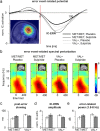Dopamine effects on human error processing depend on catechol-O-methyltransferase VAL158MET genotype
- PMID: 22049425
- PMCID: PMC6623004
- DOI: 10.1523/JNEUROSCI.2103-11.2011
Dopamine effects on human error processing depend on catechol-O-methyltransferase VAL158MET genotype
Abstract
Brain dopamine (DA) has been linked to error processing. Because high and low (vs medium) prefrontal cortex (PFC) DA levels may facilitate D2-receptor-related modulations of PFC neural activation patterns, we hypothesized that high and low DA predicts increased error-specific transitions of PFC activity. Male human participants (n = 169) were genotyped for the catechol-O-methyltransferase (COMT) Val158Met polymorphism, associated with low (Val) and medium (Met) PFC DA levels. In addition, DRD2TaqIa and 5-HTTLPR, associated with striatal D(2) receptor density and serotonin uptake, respectively, were assessed. Participants received placebo or a selective DA-D(2) receptor blocker (sulpiride, 200 mg) and performed a Flanker task. EEG was recorded and decomposed into independent brain components (ICs) using independent component analysis. After errors, participants displayed (1) a negative deflection in ICs source-localized to the proximity of the anterior midcingulate cortex [IC-error-related negativity (IC-ERN)], (2) increased midcingulate cortex IC power in the delta/theta frequency range, and (3) slowing in the subsequent trial [posterror slowing (PES)]. Importantly, all, IC-ERN, delta/theta power, and PES were modulated by COMT × Substance interactions such that the Val allele predicted elevated IC-ERN, delta/theta power, and PES after placebo; this association was reversed under sulpiride. Because low doses of sulpiride presumably increase PFC DA levels, the COMT × Substance interaction supports the hypothesis that low (Val, placebo) and high (Met, sulpiride) versus medium (Val, sulpiride; Met, placebo) DA levels elevate reactivity to errors. Consistent with an influence of serotonin on PFC DA, the COMT × Substance interaction was modulated by 5-HTTLPR.
Figures




References
-
- Alain C, McNeely HE, He Y, Christensen BK, West R. Neurophysiological evidence of error-monitoring deficits in patients with schizophrenia. Cereb Cortex. 2002;12:840–846. - PubMed
-
- Bilder RM, Volavka J, Lachman HM, Grace AA. The catechol-O-methyltransferase polymorphism: relations to the tonic-phasic dopamine hypothesis and neuropsychiatric phenotypes. Neuropsychopharmacology. 2004;29:1943–1961. - PubMed
-
- Borroni B, Grassi M, Agosti C, Archetti S, Costanzi C, Cornali C, Caltagirone C, Caimi L, Di Luca M, Padovani A. Cumulative effect of COMT and 5-HTTLPR polymorphisms and their interaction with disease severity and comorbidities on the risk of psychosis in Alzheimer disease. Am J Geriatr Psychiatry. 2006;14:343–351. - PubMed
-
- Botvinick M, Nystrom LE, Fissell K, Carter CS, Cohen JD. Conflict monitoring versus selection-for-action in anterior cingulate cortex. Nature. 1999;402:179–181. - PubMed
-
- Botvinick MM, Braver TS, Barch DM, Carter CS, Cohen JD. Conflict monitoring and cognitive control. Psychol Rev. 2001;108:624–652. - PubMed
Publication types
MeSH terms
Substances
LinkOut - more resources
Full Text Sources
Miscellaneous
